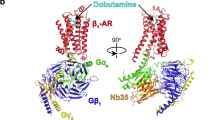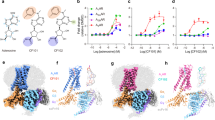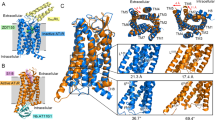Abstract
G-protein-coupled receptors (GPCRs) are essential components of the signalling network throughout the body. To understand the molecular mechanism of G-protein-mediated signalling, solved structures of receptors in inactive conformations and in the active conformation coupled to a G protein are necessary1,2. Here we present the structure of the adenosine A2A receptor (A2AR) bound to an engineered G protein, mini-Gs, at 3.4 Å resolution. Mini-Gs binds to A2AR through an extensive interface (1,048 Å2) that is similar, but not identical, to the interface between Gs and the β2-adrenergic receptor3. The transition of the receptor from an agonist-bound active-intermediate state4,5 to an active G-protein-bound state is characterized by a 14 Å shift of the cytoplasmic end of transmembrane helix 6 (H6) away from the receptor core, slight changes in the positions of the cytoplasmic ends of H5 and H7 and rotamer changes of the amino acid side chains Arg3.50, Tyr5.58 and Tyr7.53. There are no substantial differences in the extracellular half of the receptor around the ligand binding pocket. The A2AR–mini-Gs structure highlights both the diversity and similarity in G-protein coupling to GPCRs6 and hints at the potential complexity of the molecular basis for G-protein specificity.
This is a preview of subscription content, access via your institution
Access options
Subscribe to this journal
Receive 51 print issues and online access
$199.00 per year
only $3.90 per issue
Buy this article
- Purchase on Springer Link
- Instant access to full article PDF
Prices may be subject to local taxes which are calculated during checkout




Similar content being viewed by others
References
Kobilka, B. K. Structural insights into adrenergic receptor function and pharmacology. Trends Pharmacol. Sci. 32, 213–218 (2011)
Venkatakrishnan, A. J. et al. Molecular signatures of G-protein-coupled receptors. Nature 494, 185–194 (2013)
Rasmussen, S. G. et al. Crystal structure of the β2 adrenergic receptor-Gs protein complex. Nature 477, 549–555 (2011)
Lebon, G. et al. Agonist-bound adenosine A2A receptor structures reveal common features of GPCR activation. Nature 474, 521–525 (2011)
Xu, F. et al. Structure of an agonist-bound human A2A adenosine receptor. Science 332, 322–327 (2011)
Flock, T. et al. Universal allosteric mechanism for Gα activation by GPCRs. Nature 524, 173–179 (2015)
Doré, A. S. et al. Structure of the adenosine A2A receptor in complex with ZM241385 and the xanthines XAC and caffeine. Structure 19, 1283–1293 (2011)
Hino, T. et al. G-protein-coupled receptor inactivation by an allosteric inverse-agonist antibody. Nature 482, 237–240 (2012)
Jaakola, V. P. et al. The 2.6 angstrom crystal structure of a human A2A adenosine receptor bound to an antagonist. Science 322, 1211–1217 (2008)
Lebon, G., Edwards, P. C., Leslie, A. G. & Tate, C. G. Molecular determinants of CGS21680 binding to the human adenosine A2A receptor. Mol. Pharmacol. 87, 907–915 (2015)
Lebon, G., Warne, T. & Tate, C. G. Agonist-bound structures of G protein-coupled receptors. Curr. Opin. Struct. Biol. 22, 482–490 (2012)
Congreve, M. et al. Discovery of 1,2,4-triazine derivatives as adenosine A2A antagonists using structure based drug design. J. Med. Chem. 55, 1898–1903 (2012)
Liu, W. et al. Structural basis for allosteric regulation of GPCRs by sodium ions. Science 337, 232–236 (2012)
Miller-Gallacher, J. L. et al. The 2.1 Å resolution structure of cyanopindolol-bound β1-adrenoceptor identifies an intramembrane Na+ ion that stabilises the ligand-free receptor. PLoS One 9, e92727 (2014)
Fenalti, G. et al. Molecular control of δ-opioid receptor signalling. Nature 506, 191–196 (2014)
Zhang, C. et al. High-resolution crystal structure of human protease-activated receptor 1. Nature 492, 387–392 (2012)
Huang, W. et al. Structural insights into μ-opioid receptor activation. Nature 524, 315–321 (2015)
Murphree, L. J., Marshall, M. A., Rieger, J. M., MacDonald, T. L. & Linden, J. Human A2A adenosine receptors: high-affinity agonist binding to receptor-G protein complexes containing Gβ4 . Mol. Pharmacol. 61, 455–462 (2002)
Ballesteros, J. A. & Weinstein, H. in Methods in Neurosciences Vol. 25 (eds Sealfon, S. C. & Conn, P. M. ) 366–428 (Academic Press, 1995)
Manglik, A. et al. Structural insights into the dynamic process of β2-adrenergic receptor signaling. Cell 161, 1101–1111 (2015)
Ye, L., Van Eps, N., Zimmer, M., Ernst, O. P. & Prosser, R. S. Activation of the A2A adenosine G-protein-coupled receptor by conformational selection. Nature 533, 265–268 (2016)
Rasmussen, S. G. et al. Structure of a nanobody-stabilized active state of the β2 adrenoceptor. Nature 469, 175–180 (2011)
Rosenbaum, D. M. et al. Structure and function of an irreversible agonist-β2 adrenoceptor complex. Nature 469, 236–240 (2011)
Warne, T. et al. The structural basis for agonist and partial agonist action on a β1-adrenergic receptor. Nature 469, 241–244 (2011)
Leslie, A. G. The integration of macromolecular diffraction data. Acta Crystallogr. D 62, 48–57 (2006)
Evans, P. Scaling and assessment of data quality. Acta Crystallogr. D 62, 72–82 (2006)
McCoy, A. J. et al. Phaser crystallographic software. J. Appl. Crystallogr. 40, 658–674 (2007)
Murshudov, G. N. et al. REFMAC5 for the refinement of macromolecular crystal structures. Acta Crystallogr. D 67, 355–367 (2011)
Emsley, P., Lohkamp, B., Scott, W. G. & Cowtan, K. Features and development of Coot. Acta Crystallogr. D 66, 486–501 (2010)
Potterton, L. et al. Developments in the CCP4 molecular-graphics project. Acta Crystallogr. D 60, 2288–2294 (2004)
Acknowledgements
This work was supported by a grant from Heptares Therapeutics Ltd., the ERC (grant EMPSI 339995) and core funding from the Medical Research Council (MC_U105197215 and MC_U105184325). We thank the beamline staff at the European Synchrotron Radiation Facility (beamlines ID23-2, ID30-A3 and ID29) and at Diamond Light Source (beamline I24). We also thank R. Henderson, A. Jazayeri and T. Flock for comments on the manuscript.
Author information
Authors and Affiliations
Contributions
B.C. performed receptor expression, purification, crystallization, cryo-cooling of the crystals, data collection, data processing and structure refinement. T.W. helped with crystallization, data collection and data processing. R.N. performed the stability assays and pharmacological analyses on A2AR–mini-GS complexes. A.G.W.L. was involved in data processing and structure solution, refinement and analysis. Manuscript preparation was performed by B.C., A.G.W.L. and C.G.T. The overall project management was by C.G.T.
Corresponding authors
Ethics declarations
Competing interests
This work was funded in part by Heptares Therapeutics Ltd. C.G.T. is a consultant and member of the Scientific Advisory Board for Heptares Therapeutics Ltd.
Additional information
Reviewer Information Nature thanks O. Ernst, K. Jacobson and K.-N. Klotz for their contribution to the peer review of this work.
Extended data figures and tables
Extended Data Figure 1 Pharmacological analyses of A2AR–mini-Gs complexes.
Competition assays were performed on A2AR expressed in HEK293 cell membranes with the agonist NECA competing for the binding of radiolabelled inverse agonist 3H-ZM241385. Experiments were performed in the presence of either 100 mM KCl (a, b), 100 mM NaCl (c, d) or 500 mM NaCl (e, f) to confirm the similar behaviour of mini-Gs with heterotrimeric Gs with nanobody Nb35 for stabilization of the complex. Results are summarized in the Table (g). All error bars represent the s.e.m. for at least three independent experiments performed in duplicate. Comparisons of data in b, d and f were performed using an unpaired t-test with significance denoted by asterisks: ***P < 0.0001; **P < 0.01; *P < 0.1; not significant (NS) P > 0.1.
Extended Data Figure 2 Thermostability of detergent-solubilized 3H-NECA-bound A2AR in the presence or absence of mini-Gs.
Unpurified A2AR was solubilized in detergent at the following concentrations: a, DDM, 0.1%; b, DM, 0.13%; c, OG, 0.8%. Samples were heated for 30 min, quenched on ice and the amount of 3H-NECA bound determined. Data were analysed by nonlinear regression and apparent Tm values (transition temperature where 50% of the receptor is inactive) were determined from analysis of the sigmoidal dose–response curves fitted (d). Results represent the mean ± s.e.m. of two independent experiments, performed in duplicate.
Extended Data Figure 3 Omit maps for NECA and GDP.
a–f, Orthogonal views of omit map difference density for NECA in A2AR chain A (a, b), NECA in A2AR chain B (c, d) and GDP in mini-Gs chain C (e, f). The contour level is 2.5σ in panels a–d and 3.0σ in panels e and f. Figures were made using CCP4mg30.
Extended Data Figure 4 Electron density for the interface region of the A2AR–mini-Gs complex.
The backbones of A2AR and mini-Gs are shown in cartoon representation in light blue and magenta respectively. Side chains are shown in stick representation (carbon, light blue; oxygen, red; nitrogen, deep blue). The electron density of the final 2Fo − Fc map is shown contoured at 1.2σ. For clarity, transmembrane helices H5 and H6 and the corresponding electron density have been omitted. a, View showing the interaction between the C-terminal helix of mini-Gs and the CL2 loop of A2AR. b, View showing the interactions between side chains of the C-terminal helix of mini-Gs and three Arg residues of A2AR.
Extended Data Figure 5 Alignment of mini-Gs with GNAS2.
Comparison of amino acid residues in mini-Gs (chains C and D) within 3.9 Å of A2AR (green) in the A2AR–mini-Gs structure and the amino acid residues in bovine GNAS2 (P04896) within 3.9 Å of β2AR in the β2AR–Gs structure (turquoise). The CGN system is used for reference.
Extended Data Figure 6 Alignment of β2AR and A2AR amino acid sequences.
adrb2_human, human β2-adrenergic receptor; AA2AR_human, human adenosine A2A receptor; AA2AR chain A, chain A of the crystallized A2AR–mini-Gs structure; AA2AR chain B, chain B of the crystallized A2AR–mini-Gs structure. Residues in the receptors that are within 3.9 Å of either Gα in the β2AR–Gs complex or mini-Gs in the A2AR–mini-Gs complex are highlighted in turquoise or green, respectively. Key Ballesteros–Weinstein numbers are shown in blue and mutations in the crystallized A2AR to facilitate purification and crystallization are shown in red. Grey bars indicate the positions of α-helices in the β2AR–Gs structure, whereas red bars represent these regions in the A2AR–mini-Gs structure; where there is a discrepancy in helix length between chain A and B of A2AR, the bar is coloured pink.
Extended Data Figure 7 A conserved hydrophobic binding pocket at the receptor–Gαs interface.
The A2AR–mini-Gs complex was aligned to the β2AR–Gs complex via the receptors; A2AR, green; β2AR, turquoise; mini-Gs (purple); Gαs (grey).
Extended Data Figure 8 Comparison between receptor-bound mini-Gs and Gαs.
a–c, Three different views of an alignment of mini-Gs (chain C, purple) bound to A2AR with the GTPase domain of Gαs (grey) bound to β2AR. GDP bound to mini-Gs is depicted as a space filling model (carbon, yellow; oxygen, red; nitrogen, blue; phosphorus, orange). The α5 helix that interacts with the receptors is labelled.
Extended Data Figure 9 Comparison of the NECA binding site in the active-intermediate state compared to the mini-Gs-bound state.
The structure of NECA-bound A2AR (grey cartoon, with the carbon atoms of NECA also in grey) in the active-intermediate state was aligned with the structure of the NECA-bound A2AR–mini-Gs complex (rainbow colouration, with the carbon atoms of NECA in green). Key amino acid residues for both receptors are depicted (sticks; carbon atoms in the same colour as the respective receptor) that form hydrogen bonds (red dashed line) with either NECA or the associated water network (red spheres). Note that the water molecules depicted are from only the NECA-bound A2AR structure in the active-intermediate state, because the resolution of the A2AR–mini-Gs structure was insufficient to identify water molecules. Carbonyl oxygens are denoted by ‘co’ after the residue name.
Supplementary information
Supplementary Information
This file contains a Supplementary Discussion. (PDF 79 kb)
Supplementary Table
This file contains Supplementary Table 1. (XLSX 71 kb)
Rights and permissions
About this article
Cite this article
Carpenter, B., Nehmé, R., Warne, T. et al. Structure of the adenosine A2A receptor bound to an engineered G protein. Nature 536, 104–107 (2016). https://doi.org/10.1038/nature18966
Received:
Accepted:
Published:
Issue Date:
DOI: https://doi.org/10.1038/nature18966
This article is cited by
-
Sequestration of Gβγ by deubiquitinated arrestins into the nucleus as a novel desensitization mechanism of G protein–coupled receptors
Cell Communication and Signaling (2023)
-
Structural basis of dimerization of chemokine receptors CCR5 and CXCR4
Nature Communications (2023)
-
Structural basis of signaling regulation of the human melanocortin-2 receptor by MRAP1
Cell Research (2023)
-
Structural insights into the agonists binding and receptor selectivity of human histamine H4 receptor
Nature Communications (2023)
-
The dynamics of agonist-β2-adrenergic receptor activation induced by binding of GDP-bound Gs protein
Nature Chemistry (2023)
Comments
By submitting a comment you agree to abide by our Terms and Community Guidelines. If you find something abusive or that does not comply with our terms or guidelines please flag it as inappropriate.



